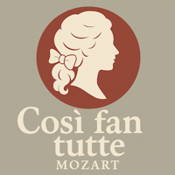
Overview
Synopsis
A hilarious farce, Così fan tutte revolved around a bet made among three men; Don Alfonso, the older and more cynical of the bunch, bets Ferrando and Guglielmo that he can prove that their girlfriends, Fiordiligi and Dorabella, are unfaithful like all women. Don Alfonso, with the help of Despina, the girls’ maid, sets up the plot to pretend to send the men off to war, but then disguise them as “Albanians” in the attempts to seduce the other man’s girlfriend. After many comical struggles, and absurd tricks, Despina and Alfonso succeed in duping the quartet and putting the two couples into situations where they are forced to decide. Both girls agree to marry the “Albanians,” and Fiordiligi and Ferrando have appeared to have fallen in love, when it is announced that their old boyfriends have returned home. The men reveal themselves, and the ladies ask for their forgiveness. Alfonso wins the bet and gloats, hoping that they have all learned their lesson.
Show Information
Context
Wolfgang Amadeus Mozart’s Così fan tutte (translated as Thus Do All Women) premiered in Vienna in 1790 at the Burgtheater. The opera represents the third and final collaboration between Mozart and librettist Lorenzo Da Ponte, following The Marriage of Figaro (1786) and Don Giovanni (1787). While the earlier operas were acclaimed for their blend of comedy and social commentary, Così fan tutte offered a more intimate exploration of love, loyalty, and human folly, packaged in the witty
to read the context for Così fan tutte and to unlock other amazing theatre resources!Plot
Act I
Scene 1 – A Coffeehouse in Naples
Ferrando and Guglielmo, two young officers, boast of their fiancées’ fidelity in the trio “La mia Dorabella” and “Fiordiligi, mio tesoro.” Their older, skeptical friend Don Alfonso counters with the cynical aria “È la fede delle femmine”, arguing that all women are fickle. He challenges them to a wager: he will prove their lovers unfaithful within a single day. Confident in Dorabella and Fiordiligi’s constancy, the young men accept.
**Scene 2 –
to read the plot for Così fan tutte and to unlock other amazing theatre resources!Characters
| Name | Part Size | Gender | Vocal Part |
|---|---|---|---|
|
Lead |
Female |
Soprano |
|
|
Lead |
Male |
Tenor |
|
|
Lead |
Female |
Mezzo-Soprano |
|
|
Lead |
Male |
Bass |
|
|
Supporting |
Female |
Soprano |
|
|
Supporting |
Male |
Bass |
|
|
Ensemble |
Either Gender |
|
Songs
Act I
Act II
A song with an asterisk (*) before the title indicates a dance number.
Monologues
Scenes
Key Terms
An aria is a solo vocal piece in an opera or oratorio that showcases the singer’s range and emotional expression. It is typically performed with orchestral accompaniment and often marks a moment of reflection or emotional climax.
Farce is a comedic style that emphasizes exaggerated situations, improbable coincidences, mistaken identities, and rapid pacing. It often includes physical humor such as slamming doors, frantic chases, or characters hiding in plain sight. Farce is designed to generate nonstop laughter, often prioritizing chaos and absurdity over realistic storytelling.
A comedic form of opera that developed in the 18th century, featuring everyday characters and humorous plots. It contrasts with the more serious opera seria.
A style of vocal delivery in opera where the singer adopts the rhythms of ordinary speech. It advances plot between arias and provides narrative context.
Recognizable character types used across theatrical traditions, such as the fool, villain, or ingenue.
Videos
Quizzes
Themes, Symbols & Motifs
Themes
Fidelity and Betrayal
At the opera’s
to read about the themes, symbols and motifs from Così fan tutte and to unlock other amazing theatre resources!Quote Analysis
Sorry! We do not currently have learning modules for this guide.

